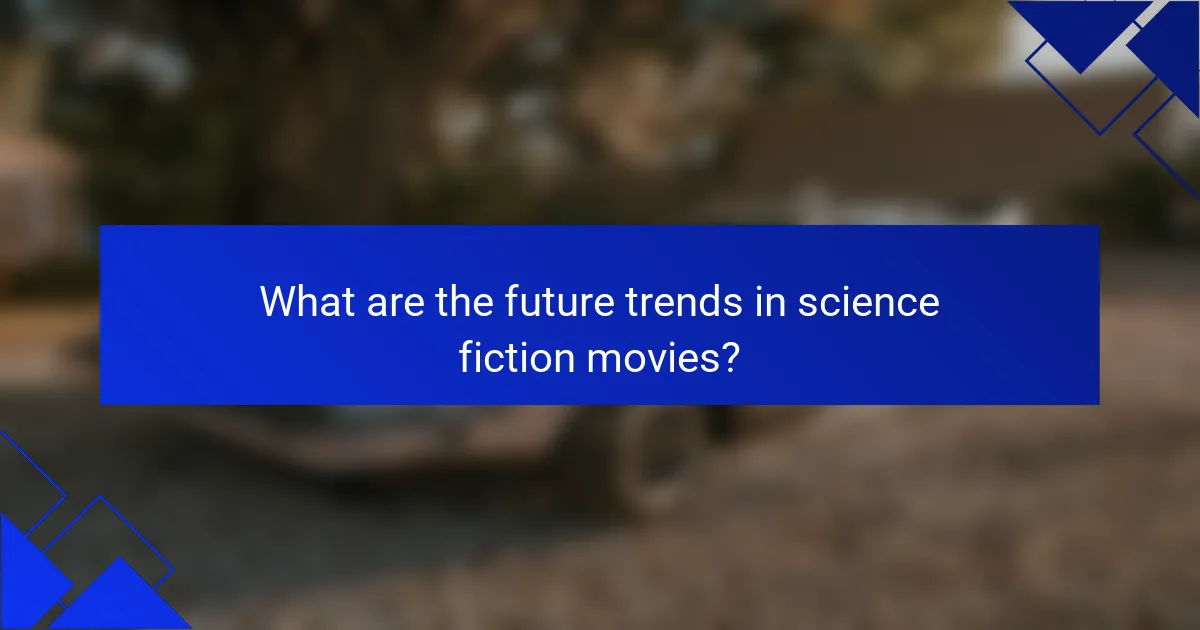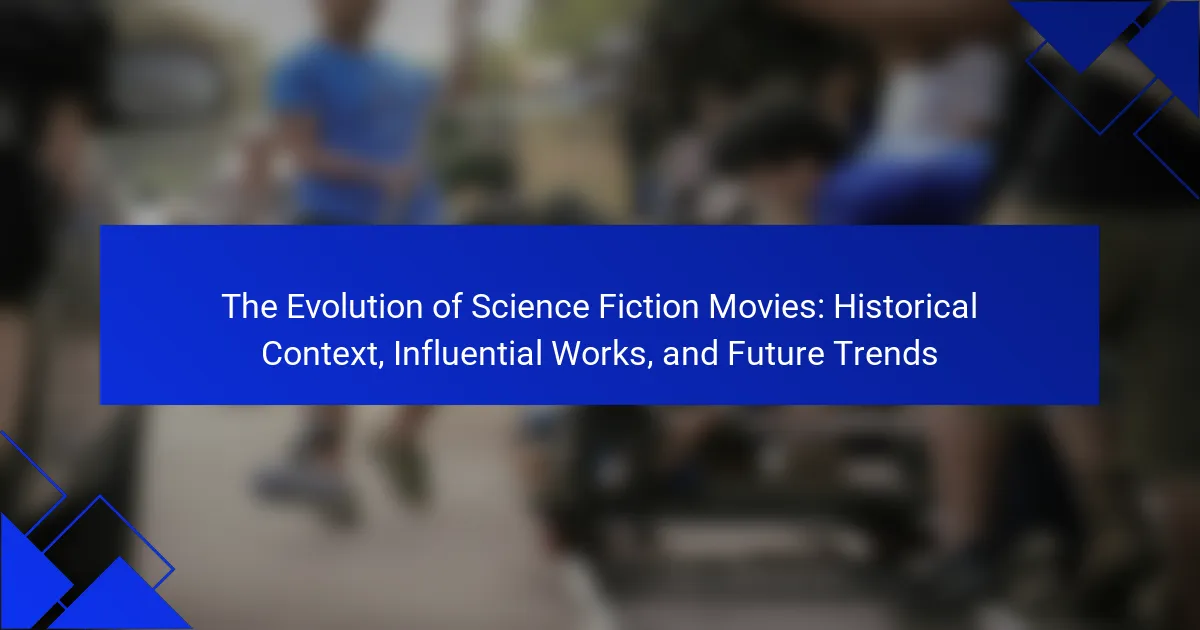
What is the historical context of science fiction movies?
Science fiction movies emerged in the early 20th century. The genre reflects societal anxieties and technological advancements. The first science fiction film, “A Trip to the Moon,” was released in 1902. This silent film showcased imaginative storytelling and special effects. The genre gained popularity during the 1950s, influenced by the Space Race. Films like “The Day the Earth Stood Still” addressed Cold War fears. The 1977 release of “Star Wars” revolutionized the genre and special effects technology. Science fiction films often explore themes of identity, humanity, and dystopia. The genre continues to evolve, reflecting contemporary issues and future possibilities.
How did early cinema influence the development of science fiction?
Early cinema significantly influenced the development of science fiction by introducing visual storytelling techniques that brought imaginative concepts to life. Pioneering films like Georges Méliès’ “A Trip to the Moon” in 1902 showcased special effects and narrative structures that became foundational to the genre. These early works demonstrated how film could explore themes of space travel, time manipulation, and futuristic technologies. The visual representation of speculative ideas captivated audiences and inspired future filmmakers. Furthermore, early cinema established a framework for genre conventions that would shape science fiction narratives for decades. The combination of innovative visuals and storytelling laid the groundwork for the evolution of science fiction in cinema.
What were the first science fiction films and their significance?
The first science fiction films include “A Trip to the Moon” (1902) and “Metropolis” (1927). “A Trip to the Moon,” directed by Georges Méliès, is significant for its innovative special effects and narrative structure. It depicts a whimsical journey to the moon, showcasing early cinematic creativity. “Metropolis,” directed by Fritz Lang, is notable for its elaborate set design and themes of class struggle. It represents the technological anxieties of the 1920s and influenced future dystopian films. Both films laid the groundwork for the science fiction genre, inspiring filmmakers and expanding the possibilities of storytelling in cinema.
How did societal events shape the themes in early science fiction movies?
Societal events significantly influenced the themes in early science fiction movies. The aftermath of World War II prompted fears of nuclear war, leading to themes of destruction and survival. Films like “The Day the Earth Stood Still” reflected anxiety about alien encounters and humanity’s future. The Cold War era introduced paranoia and distrust, evident in movies such as “Invasion of the Body Snatchers.” Technological advancements also shaped narratives, with a fascination for space exploration seen in “Destination Moon.” Economic challenges influenced dystopian themes, highlighting societal breakdowns in films like “Metropolis.” These societal contexts provided a framework for filmmakers to explore complex human issues through speculative scenarios.
What role did literature play in the evolution of science fiction films?
Literature has been foundational in the evolution of science fiction films. It provided the original narratives and imaginative concepts that filmmakers adapted for the screen. Classic literary works, such as Mary Shelley’s “Frankenstein” and H.G. Wells’ “The War of the Worlds,” directly inspired early science fiction cinema. These stories introduced themes of technology, alien encounters, and dystopian futures.
As science fiction literature evolved, it continued to influence filmmakers. The rise of authors like Isaac Asimov and Arthur C. Clarke introduced complex ideas about robotics and space exploration. Their works laid the groundwork for films such as “2001: A Space Odyssey.”
Adaptations from literature often brought depth to film narratives. They offered rich world-building and character development, enhancing audience engagement. The success of literary adaptations demonstrated the viability of science fiction as a film genre.
In summary, literature has played a crucial role in shaping science fiction films by providing source material, thematic depth, and inspiring innovative storytelling.
Which literary works inspired the first science fiction movies?
The literary works that inspired the first science fiction movies include “Frankenstein” by Mary Shelley and “The Time Machine” by H.G. Wells. “Frankenstein,” published in 1818, explores themes of creation and humanity. Its narrative influenced early adaptations in film, notably “Frankenstein” in 1931. “The Time Machine,” released in 1895, introduced concepts of time travel. This work laid the groundwork for films like “The Time Machine” in 1960. Other notable influences include Jules Verne’s “Journey to the Center of the Earth” and “20,000 Leagues Under the Sea.” These texts provided foundational ideas that shaped the genre.
How did adaptations from literature impact the film industry?
Adaptations from literature significantly impacted the film industry by providing a wealth of source material. Classic novels and stories often translate well to visual storytelling. This practice allows filmmakers to draw on established narratives and character arcs. For example, adaptations of works like “The War of the Worlds” and “2001: A Space Odyssey” shaped the science fiction genre in film. These adaptations attract audiences familiar with the original texts. They also offer a ready-made fan base, increasing box office potential. Furthermore, literary adaptations often push creative boundaries in filmmaking. They encourage innovation in special effects and narrative structure. Overall, adaptations from literature have been crucial in shaping cinematic trends and audience expectations.

What are the most influential science fiction movies in history?
The most influential science fiction movies in history include “Metropolis,” “2001: A Space Odyssey,” and “Star Wars.” “Metropolis,” directed by Fritz Lang in 1927, set a visual and thematic standard for the genre. Its depiction of a dystopian future influenced countless filmmakers. “2001: A Space Odyssey,” released in 1968, revolutionized special effects and narrative structure. It introduced complex themes about humanity and technology. “Star Wars,” launched in 1977, transformed the blockbuster model and popularized space opera. Its cultural impact is evident in subsequent franchises and merchandising. Each of these films played a pivotal role in shaping science fiction cinema and its evolution.
Which films are considered milestones in science fiction cinema?
“2001: A Space Odyssey” is considered a milestone in science fiction cinema. Released in 1968, it revolutionized visual effects and narrative structure. “Star Wars,” launched in 1977, transformed the blockbuster landscape and popularized space operas. “Blade Runner,” from 1982, introduced themes of identity and artificial intelligence. “The Matrix,” released in 1999, combined philosophical concepts with groundbreaking special effects. These films have significantly influenced the genre and set new standards for storytelling and technology in cinema.
What innovations did these films introduce to the genre?
These films introduced groundbreaking visual effects and storytelling techniques to the genre. They utilized advanced CGI technology, enhancing realism and immersion. Innovations in sound design also emerged, creating a more engaging experience. The narrative structure evolved, incorporating complex themes and character development. Films like “Star Wars” popularized space operas, while “Blade Runner” introduced dystopian aesthetics. These contributions significantly shaped audience expectations and industry standards. Their influence is evident in contemporary science fiction cinema.
How did audience reception affect the legacy of these films?
Audience reception significantly shaped the legacy of science fiction films. Positive audience reactions often led to increased box office success. For instance, films like “Star Wars” received acclaim, boosting their cultural impact. Conversely, negative reception can diminish a film’s legacy. “Blade Runner” initially underperformed but gained recognition over time. Audience feedback influences critical reassessment and re-evaluation of films. This process can lead to a film’s revival in popularity through home media and streaming. Overall, audience reception plays a crucial role in determining which films endure in the public consciousness.
What themes and motifs are prevalent in influential science fiction films?
Influential science fiction films often explore themes of technology, humanity, and dystopia. Technology serves as a double-edged sword, showcasing both its benefits and dangers. Humanity is frequently examined through the lens of artificial intelligence and its impact on human identity. Dystopian futures depict societal collapse, often reflecting contemporary fears. Other prevalent motifs include space exploration, which symbolizes the quest for knowledge and adventure. The concept of time travel raises questions about fate and free will. Alien encounters challenge perceptions of what it means to be human. These themes and motifs resonate deeply with audiences, reflecting societal anxieties and aspirations.
How do these themes reflect societal concerns of their time?
Science fiction themes reflect societal concerns by addressing issues like technology, identity, and morality. For example, the rise of dystopian narratives in the 1980s mirrored fears of government control and loss of freedom. Films like “Blade Runner” tackled questions of humanity amidst technological advancement. The portrayal of alien invasions often symbolized anxieties about foreign threats or societal change. Additionally, the exploration of artificial intelligence in films like “The Matrix” highlighted concerns over the implications of technological progress. These thematic elements serve as a lens through which audiences can examine contemporary issues, making science fiction a mirror of its time.
What recurring motifs can be identified across influential works?
Recurring motifs in influential works include the exploration of identity, the clash between humanity and technology, and dystopian futures. Identity is often examined through characters grappling with their existence and purpose. The tension between humanity and technology highlights ethical dilemmas and consequences of advancements. Dystopian settings serve as cautionary tales about societal issues. These motifs appear in classics like “Blade Runner” and “The Matrix.” They reflect cultural anxieties and aspirations. Their prevalence demonstrates how science fiction mirrors real-world concerns.

What are the future trends in science fiction movies?
Future trends in science fiction movies include increased focus on artificial intelligence and virtual reality. Filmmakers are exploring the ethical implications of technology. This trend reflects societal concerns about AI’s role in daily life. Additionally, there is a rise in diverse storytelling perspectives. More filmmakers from varied backgrounds are creating unique narratives. Environmental themes are also becoming prominent in sci-fi plots. This shift addresses climate change and sustainability issues. Finally, advancements in CGI technology enhance visual storytelling. This allows for more imaginative worlds and scenarios. These trends indicate a dynamic evolution in the genre.
How is technology influencing the future of science fiction filmmaking?
Technology is significantly influencing the future of science fiction filmmaking. Advances in visual effects allow filmmakers to create more realistic and immersive worlds. Innovations in CGI have transformed how alien landscapes and futuristic cities are depicted. Virtual reality technology enables interactive storytelling experiences. Filmmakers can now utilize real-time rendering to visualize scenes instantly. Additionally, artificial intelligence is being used in scriptwriting and editing processes. This enhances creativity and streamlines production. Streaming platforms are also changing distribution methods, allowing for diverse storytelling. These technological advancements are reshaping audience engagement and expectations in science fiction films.
What advancements in special effects are shaping new films?
Advancements in special effects shaping new films include real-time rendering, virtual reality, and AI-driven animation. Real-time rendering allows filmmakers to visualize scenes instantly. This technology enhances creative flexibility during production. Virtual reality immerses audiences in interactive experiences. It transforms storytelling by allowing viewer participation. AI-driven animation streamlines the creation of lifelike characters. This results in more engaging narratives. Motion capture technology captures actors’ performances with high accuracy. This technique improves character realism in animated films. These advancements collectively push the boundaries of cinematic storytelling.
How are streaming services changing the landscape of science fiction cinema?
Streaming services are significantly altering the landscape of science fiction cinema. They provide a platform for diverse storytelling and innovative concepts. Traditional studios often focus on blockbuster franchises. Streaming services allow for niche projects that may not attract theatrical distribution. This change fosters creativity and experimentation within the genre. For instance, series like “The Expanse” and “Stranger Things” showcase unique narratives. Additionally, streaming platforms enable global access to science fiction content. Viewers worldwide can explore various interpretations of the genre. Data indicates that original science fiction content on platforms like Netflix has increased by over 50% in recent years. This trend reflects the growing demand for fresh and varied science fiction experiences.
What emerging themes are likely to define the next generation of science fiction films?
Emerging themes likely to define the next generation of science fiction films include climate change, artificial intelligence, and social justice. Climate change narratives will explore dystopian futures shaped by environmental collapse. Films will depict the consequences of neglecting ecological responsibility. Artificial intelligence themes will delve into the ethical implications of advanced technology. They will question what it means to be human in an era of machines. Social justice themes will address inequality and representation. These films will highlight marginalized voices and experiences. The increasing popularity of these themes reflects societal concerns. Audiences seek stories that resonate with current global challenges.
How are contemporary issues being reflected in upcoming science fiction narratives?
Contemporary issues are reflected in upcoming science fiction narratives through themes such as climate change, social justice, and technology’s impact on society. These narratives often depict dystopian futures shaped by environmental collapse, highlighting the urgency of climate action. Films like “Dune” address resource scarcity and ecological degradation, resonating with current environmental concerns. Additionally, social justice themes are increasingly prominent, exploring race, gender, and inequality. Works like “The Matrix Resurrections” challenge traditional power structures and advocate for marginalized voices. Furthermore, narratives often scrutinize technology’s role in our lives, as seen in “Black Mirror,” which critiques digital surveillance and artificial intelligence. This reflection of contemporary issues serves to engage audiences and provoke critical discussions about the future.
What role will diversity play in the evolution of science fiction storytelling?
Diversity will significantly enhance the evolution of science fiction storytelling. Diverse perspectives introduce new narratives and themes. This leads to richer, more complex plots that resonate with a broader audience. Representation of varied cultures and identities fosters inclusivity. It challenges conventional tropes and expands the genre’s boundaries. For instance, works like “Black Panther” and “Crazy Rich Asians” have shown that diverse storytelling can achieve commercial success. Additionally, the rise of diverse creators in the industry is reshaping the narrative landscape. This shift encourages innovation and exploration of underrepresented experiences in science fiction.
What practical tips can filmmakers consider for creating impactful science fiction movies?
Filmmakers can create impactful science fiction movies by focusing on strong world-building. This involves establishing a believable and immersive universe. Incorporating relatable characters enhances audience connection. A compelling narrative that explores relevant themes can resonate deeply. Visual effects should support the story, not overshadow it. Practical effects often add a tangible quality to the film. Collaborating with experts can lend authenticity to scientific concepts. Testing concepts with focus groups can provide valuable audience feedback. These strategies have been employed in successful films like “Blade Runner” and “Interstellar,” which are noted for their rich storytelling and visual innovation.
The main entity of the article is science fiction movies, which have evolved significantly since their inception in the early 20th century. The article provides a comprehensive overview of the historical context of the genre, highlighting key films such as “A Trip to the Moon,” “Metropolis,” and “Star Wars,” and their societal influences. It discusses the impact of early cinema and literature on the development of science fiction, as well as the thematic exploration of technology, identity, and dystopia in influential works. Additionally, the article examines future trends in the genre, including advancements in technology, emerging themes, and the importance of diversity in storytelling.
